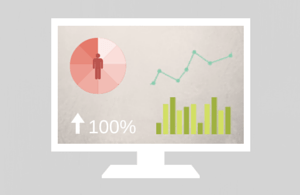
You can’t write a thesis without some solid evidence to make sure you don’t get ousted as a charlatan.
That’s true of creating web content too, you know. You may be crafting delicious stories that make your company sound just beautiful – but what’s driving it? Sure, it’s a creative process. But every industry has a solid bottom line and people want a big bang for their buck.
You need data
It’s not the be-all and end-all (it takes a bunch of intensely clever guys hours to look through data for patterns that are pretty much just fancy guess work IMO) but web analytics data can give you a hint as to what your audience is thinking and feeling, and at which points you should be connecting with them.
Nothing in marketing is just numbers because what are we marketing to? That’s right: those two-legged, hairy monkey-type things called humans. And they have thoughts and feelings beyond digits in a spreadsheet.
But not too much data
The amount of data we see these days is absolutely, stratospherically massive. Your fridge is telling me what ingredients you have available to cook dinner for me tonight. You didn’t even ask me yet (awkward), but your white goods are conspiring with your digital To Do list.
However, do not talk to me about Big Data. I will scream in your face. In amongst all that rubbish are people – who we all naturally empathise with (unless you’re a sociopath, which is apparently more common than one might think).
To produce good content, you don’t want ALL the numbers. You need some nice thick swathes of general pointers, such as “We think that people like this title because they hang around possibly reading the paragraph underneath and then click the button at the bottom.”
And don’t be duped by the data
Misunderstanding the analytics data you’re seeing because you just, oh REALLY WANT TO can be an incredibly wasteful mistake.
Imagine launching a huge hippo-themed social campaign on the strength of some numbers that you thought could maybe be jigged about to show that people go dotty for hippos. When actually, they just spent a while trying to figure out why the hell your homepage was covered in hippos. Your campaign fails, the hippo gets it…everyone loses.
Before coming up with a lovely explanation for the data, make sure the other, less-attractive possibilities have been ruled out.
Some dubious things:
- People spend quite a bit of time on this page, which means they like it – let’s do more hippos!
Really? What if they’re spending so long because one of your buttons doesn’t work too well and they’ve spent two precious minutes trying to submit their details? Go look at your conversion rates, then come back and tell me again how much people like it.
- This blog post has been visited 121 times so people definitely want more information about stove pipe filters.
According to a study by Incapsula, up to 61.5% of all website traffic is not from humans. Woah. Key message here: take those visits with a pinch of salt because it’s likely a fair number are from scrapers, hackers, spammers and impersonators.
Are people commenting, sharing, and linking to the post? What’s their time on page like, and do the demographics match up with your target audience?
Once you’ve built up a bank of posts, comparing content performance analytics is a good way of deciding which type of content takes the cakepop, but don’t pin everything on a digit here or there.
Some reasonable things:
- Tablet users bounce on this page so maybe we need some more mobile-friendly content.
It’s safe to assume that these people are leaving because your content isn’t nice to look at for them – rather than all tablet users are meanies. Do some testing of your user journeys across mobile and tablet, write some shorter copy and make sure your graphics are responsive.
- We get way more engagement with this type of content on Facebook than on Twitter so we should try another format for Twitter.
Different platforms, different tones bro. Facebook is very browse-y, whereas Twitter is much faster and punchier – obviously, it’s a 140 character affair. Think about how people talk to you on different networks and tailor your voice to connect with them.
A time and a place
Knowledge upfront is great but the point at which I get super hungry for data is after the fact. I want to know if people like my content, sure, but I also NEED to know. If I keep sending out stuff I think is nice but is absolutely bombing in the real world, I need to know the reason so I can stop doing it.
So here it is: get some data to snack on while you’re creating your lovely content, to give you not only structure but also due cause in the eyes of the bosses. Then send it out into the world and wait for the numbers to come back and tell you how to do it better next time.
Data. Yum.
[bctt tweet=”Without analytics, your story ends here. Check the numbers and write an even better one next time.”]
Don’t know where to start with your analytics? Check out Megalytic – my favourite new data muncher for people who hate data.
